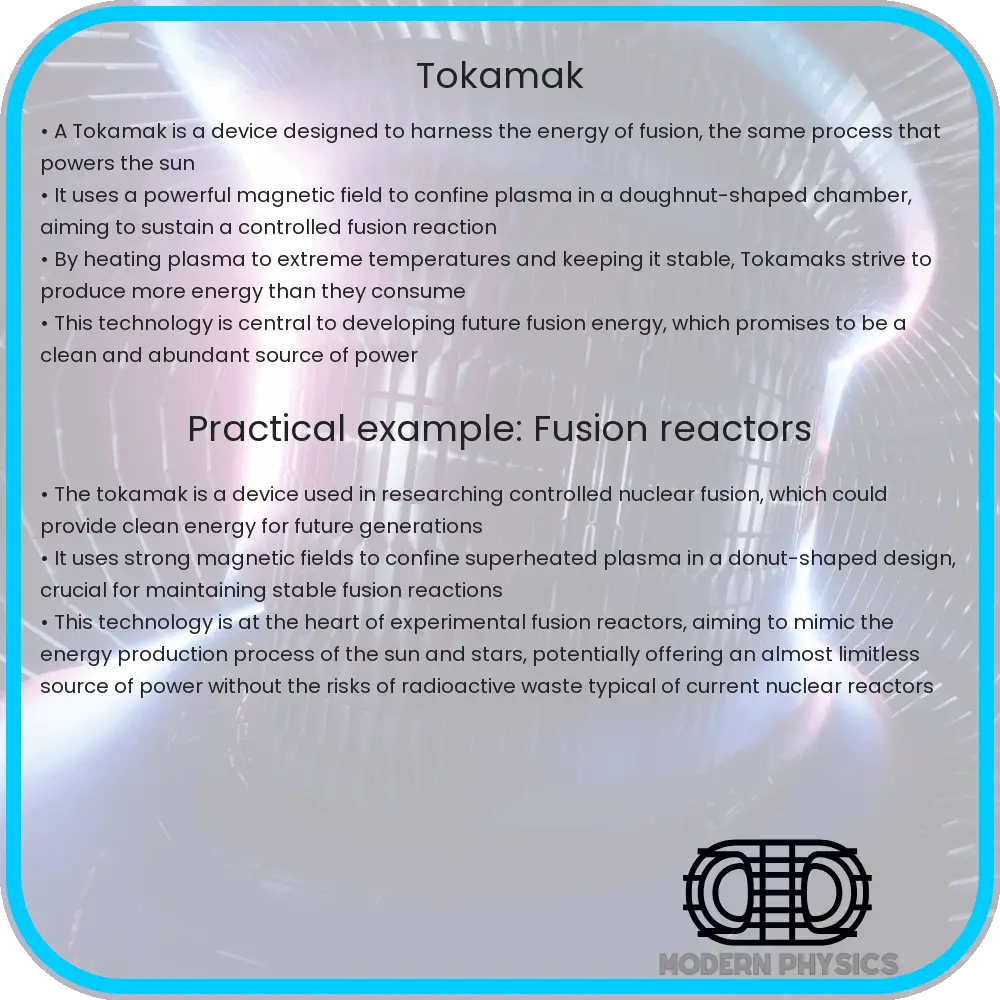Explore the advancements in tokamak technology for fusion energy, highlighting the potential for a clean, unlimited power source and the challenges ahead.

Exploring the Frontiers of Fusion Energy: Tokamak Technology
The quest for a clean, virtually unlimited source of energy has led scientists and engineers to explore the potential of nuclear fusion, a process that powers the sun and the stars. Among the various approaches to achieve controlled fusion on Earth, the tokamak, a device designed to harness the power of plasma, stands out as the most researched and promising path forward. This article delves into the cutting-edge developments in tokamak technology, highlighting its principles, advancements, and the challenges that lie ahead in realizing fusion as a practical energy source.
The Tokamak: A Marvel of Magnetic Confinement
At the heart of tokamak technology lies the concept of magnetic confinement. A tokamak is a toroidal (doughnut-shaped) chamber designed to contain and control plasma — a hot, charged state of matter composed of positive ions and free electrons. The tokamak utilizes powerful magnetic fields to confine this plasma, enabling the high temperatures and pressures necessary for fusion reactions to occur. The most common fusion reaction pursued in tokamak research is between deuterium and tritium, two heavy isotopes of hydrogen, which fuse to form helium and release a neutron, alongside a significant amount of energy. The reaction can be represented as:
2H + 3H → 4He + n + energy
Advancements in Tokamak Research
Recent years have seen remarkable progress in tokamak research, driven by international collaborations and technological innovations. Projects like ITER (International Thermonuclear Experimental Reactor) in France aim to demonstrate the feasibility of fusion as a large-scale, carbon-neutral source of energy. ITER’s design reflects decades of research, incorporating advanced magnetic confinement techniques, superconducting magnets, and heat-resistant materials to withstand the extreme conditions inside the tokamak.
Another significant advancement is the development of high-temperature superconductors. These materials can create stronger magnetic fields with less energy input, improving the efficiency of plasma confinement and increasing the likelihood of achieving net energy gain — where the energy produced by fusion exceeds the energy consumed to initiate and sustain the reaction.
Despite these advancements, challenges remain. Achieving and maintaining the precise conditions for fusion requires intricate control of the plasma, while the development of materials capable of withstanding the intense neutron bombardment from the fusion reactions is ongoing. Moreover, the transition from experimental reactors to commercial fusion power plants entails significant engineering, regulatory, and economic hurdles.
Navigating Challenges in Fusion Energy Development
The road to commercial fusion power is fraught with technical and scientific challenges, yet the potential rewards justify the global investment in tokamak research. One of the most significant challenges is the issue of plasma stability. Plasma, in its intensely hot and energetic state, is prone to various instabilities that can disrupt the fusion process. Advanced control systems using real-time magnetic and kinetic feedback are being developed to manage these instabilities, ensuring that the plasma remains in an optimal state for fusion.
Another area of focus is the development of a sustainable fuel cycle, particularly for tritium, a key fuel component in tokamak reactors that is scarce and must be bred within the reactor itself. Research is ongoing into materials and methods that can efficiently breed tritium from lithium, paving the way for a self-sustaining reactor design.
Material science also plays a critical role in tokamak development. The inner walls of the tokamak are subjected to extreme thermal stress and neutron radiation, which can degrade most materials over time. Research into new, more resilient materials, such as tungsten and composite ceramics, is crucial to developing a reactor capable of long-term operation.
Looking Toward a Fusion-Powered Future
The pursuit of fusion energy is more than a scientific endeavor; it is a pathway to a sustainable energy future. Tokamak technology, with its potential for limitless, clean energy, represents a beacon of hope in addressing the world’s growing energy needs while combating climate change. The progress in tokamak research and development, characterized by international collaborations and technological breakthroughs, underscores a collective commitment to unlocking fusion’s potential.
As we stand on the brink of a new energy era, the challenges ahead are significant but not insurmountable. With continued investment, research, and international cooperation, tokamak technology could well become the cornerstone of a clean energy economy. The journey from experimental reactors to commercial power plants is complex and requires overcoming numerous engineering and scientific hurdles. However, the benefits of a successful fusion energy system — clean, abundant, safe energy — are unparalleled, offering a transformative solution to the global energy crisis and a sustainable path forward for humanity.
Conclusion
The exploration of tokamak technology in the quest for fusion energy highlights a critical juncture in our pursuit of sustainable energy solutions. While challenges remain in realizing practical, commercial-scale fusion power, the advancements in magnetic confinement, plasma control, and materials science offer promising pathways to overcome these obstacles. The international fusion community’s dedication to this cause reflects a shared vision of a future powered by clean, abundant fusion energy. As we continue to push the boundaries of what is scientifically and technically possible, the dream of harnessing the power of the stars for a brighter, cleaner future on Earth becomes ever more tangible.
